Change Management Report: Diagnosis, Intervention, and Communication
VerifiedAdded on 2022/09/02
|11
|2722
|16
Report
AI Summary
This report examines change management processes at Ai Tuition Center in Malaysia, focusing on the implementation of technological advancements to enhance educational quality. It begins by discussing the importance of change management and its application in the education sector. The report then delves into the diagnosis phase, comparing the problem-centric and dialogic models, and analyzing how the tuition center employed a problem-centric approach to identify challenges such as student engagement and understanding of complex concepts. It then discusses the interventions used, at system and task levels, including communication strategies, particularly the dialogic model, to facilitate the change process. The report identifies flaws in the implementation and provides recommendations to improve the efficiency of change management, such as enhanced communication with stakeholders and staff training. The report highlights the importance of adapting to rapidly changing business environments and the tools, techniques, and processes necessary for effective change management.
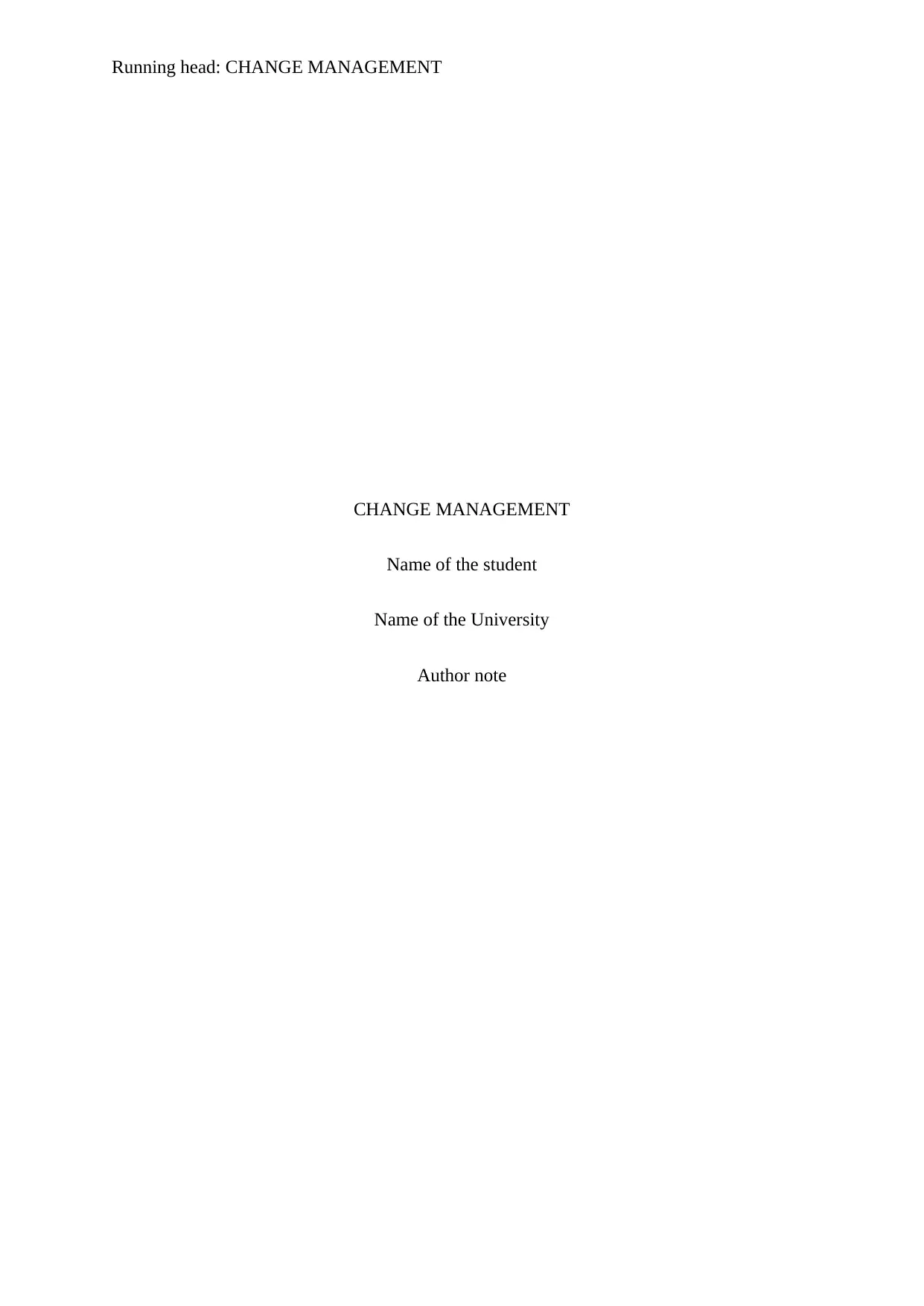
Running head: CHANGE MANAGEMENT
CHANGE MANAGEMENT
Name of the student
Name of the University
Author note
CHANGE MANAGEMENT
Name of the student
Name of the University
Author note
Paraphrase This Document
Need a fresh take? Get an instant paraphrase of this document with our AI Paraphraser
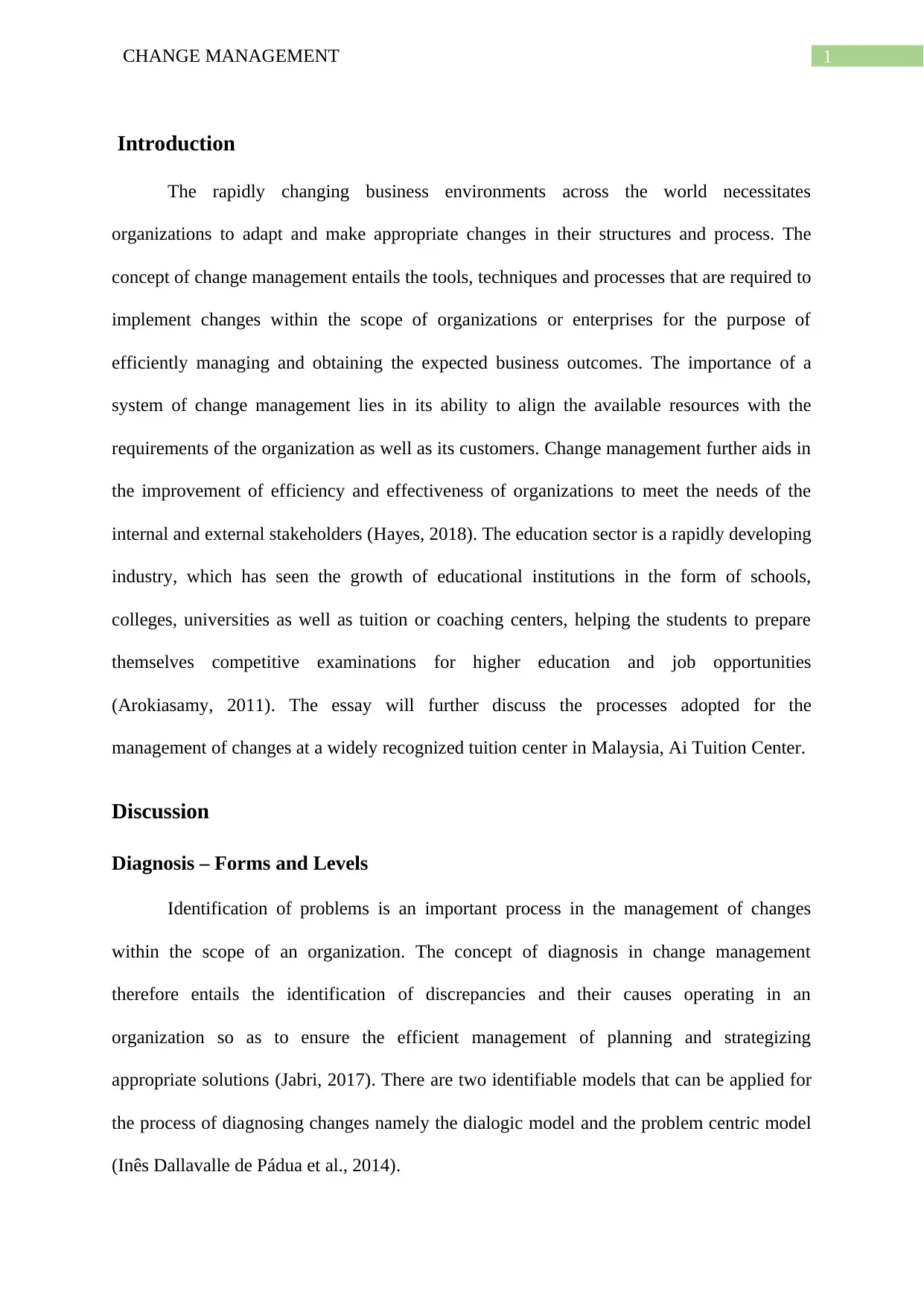
1CHANGE MANAGEMENT
Introduction
The rapidly changing business environments across the world necessitates
organizations to adapt and make appropriate changes in their structures and process. The
concept of change management entails the tools, techniques and processes that are required to
implement changes within the scope of organizations or enterprises for the purpose of
efficiently managing and obtaining the expected business outcomes. The importance of a
system of change management lies in its ability to align the available resources with the
requirements of the organization as well as its customers. Change management further aids in
the improvement of efficiency and effectiveness of organizations to meet the needs of the
internal and external stakeholders (Hayes, 2018). The education sector is a rapidly developing
industry, which has seen the growth of educational institutions in the form of schools,
colleges, universities as well as tuition or coaching centers, helping the students to prepare
themselves competitive examinations for higher education and job opportunities
(Arokiasamy, 2011). The essay will further discuss the processes adopted for the
management of changes at a widely recognized tuition center in Malaysia, Ai Tuition Center.
Discussion
Diagnosis – Forms and Levels
Identification of problems is an important process in the management of changes
within the scope of an organization. The concept of diagnosis in change management
therefore entails the identification of discrepancies and their causes operating in an
organization so as to ensure the efficient management of planning and strategizing
appropriate solutions (Jabri, 2017). There are two identifiable models that can be applied for
the process of diagnosing changes namely the dialogic model and the problem centric model
(Inês Dallavalle de Pádua et al., 2014).
Introduction
The rapidly changing business environments across the world necessitates
organizations to adapt and make appropriate changes in their structures and process. The
concept of change management entails the tools, techniques and processes that are required to
implement changes within the scope of organizations or enterprises for the purpose of
efficiently managing and obtaining the expected business outcomes. The importance of a
system of change management lies in its ability to align the available resources with the
requirements of the organization as well as its customers. Change management further aids in
the improvement of efficiency and effectiveness of organizations to meet the needs of the
internal and external stakeholders (Hayes, 2018). The education sector is a rapidly developing
industry, which has seen the growth of educational institutions in the form of schools,
colleges, universities as well as tuition or coaching centers, helping the students to prepare
themselves competitive examinations for higher education and job opportunities
(Arokiasamy, 2011). The essay will further discuss the processes adopted for the
management of changes at a widely recognized tuition center in Malaysia, Ai Tuition Center.
Discussion
Diagnosis – Forms and Levels
Identification of problems is an important process in the management of changes
within the scope of an organization. The concept of diagnosis in change management
therefore entails the identification of discrepancies and their causes operating in an
organization so as to ensure the efficient management of planning and strategizing
appropriate solutions (Jabri, 2017). There are two identifiable models that can be applied for
the process of diagnosing changes namely the dialogic model and the problem centric model
(Inês Dallavalle de Pádua et al., 2014).
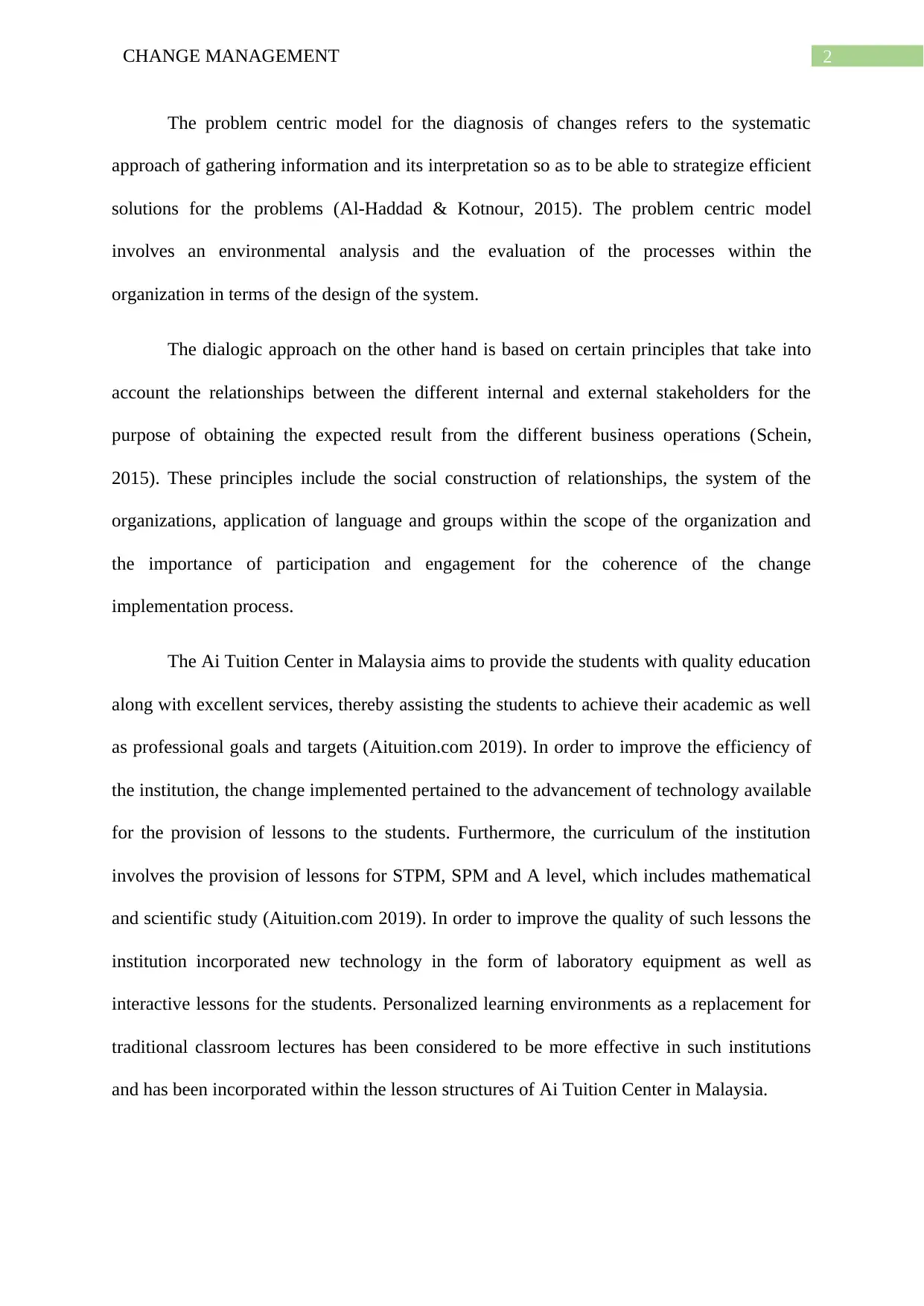
2CHANGE MANAGEMENT
The problem centric model for the diagnosis of changes refers to the systematic
approach of gathering information and its interpretation so as to be able to strategize efficient
solutions for the problems (Al-Haddad & Kotnour, 2015). The problem centric model
involves an environmental analysis and the evaluation of the processes within the
organization in terms of the design of the system.
The dialogic approach on the other hand is based on certain principles that take into
account the relationships between the different internal and external stakeholders for the
purpose of obtaining the expected result from the different business operations (Schein,
2015). These principles include the social construction of relationships, the system of the
organizations, application of language and groups within the scope of the organization and
the importance of participation and engagement for the coherence of the change
implementation process.
The Ai Tuition Center in Malaysia aims to provide the students with quality education
along with excellent services, thereby assisting the students to achieve their academic as well
as professional goals and targets (Aituition.com 2019). In order to improve the efficiency of
the institution, the change implemented pertained to the advancement of technology available
for the provision of lessons to the students. Furthermore, the curriculum of the institution
involves the provision of lessons for STPM, SPM and A level, which includes mathematical
and scientific study (Aituition.com 2019). In order to improve the quality of such lessons the
institution incorporated new technology in the form of laboratory equipment as well as
interactive lessons for the students. Personalized learning environments as a replacement for
traditional classroom lectures has been considered to be more effective in such institutions
and has been incorporated within the lesson structures of Ai Tuition Center in Malaysia.
The problem centric model for the diagnosis of changes refers to the systematic
approach of gathering information and its interpretation so as to be able to strategize efficient
solutions for the problems (Al-Haddad & Kotnour, 2015). The problem centric model
involves an environmental analysis and the evaluation of the processes within the
organization in terms of the design of the system.
The dialogic approach on the other hand is based on certain principles that take into
account the relationships between the different internal and external stakeholders for the
purpose of obtaining the expected result from the different business operations (Schein,
2015). These principles include the social construction of relationships, the system of the
organizations, application of language and groups within the scope of the organization and
the importance of participation and engagement for the coherence of the change
implementation process.
The Ai Tuition Center in Malaysia aims to provide the students with quality education
along with excellent services, thereby assisting the students to achieve their academic as well
as professional goals and targets (Aituition.com 2019). In order to improve the efficiency of
the institution, the change implemented pertained to the advancement of technology available
for the provision of lessons to the students. Furthermore, the curriculum of the institution
involves the provision of lessons for STPM, SPM and A level, which includes mathematical
and scientific study (Aituition.com 2019). In order to improve the quality of such lessons the
institution incorporated new technology in the form of laboratory equipment as well as
interactive lessons for the students. Personalized learning environments as a replacement for
traditional classroom lectures has been considered to be more effective in such institutions
and has been incorporated within the lesson structures of Ai Tuition Center in Malaysia.
⊘ This is a preview!⊘
Do you want full access?
Subscribe today to unlock all pages.

Trusted by 1+ million students worldwide

3CHANGE MANAGEMENT
The process of change implementation and the identification of the challenges faced
by the institution in terms of competition and engagement of the students has been diagnosed
using the problem-centric model. As discussed earlier, the problem-centric approach involves
the usage of an elaborate analysis of the external and internal environment of organizations in
order to identify the problems that are being currently faced or may be faced in the future.
The environmental analysis of the institution has identified that using advanced technology
for the purpose of providing high quality of education to the students is more efficient than
the traditional classroom system, and may also help the institution to reduce its competition
in the education sector (Verhulst & Lambrechts, 2015). The problems identified in the
institution through this approach is that of a lack of engagement among the students and
difficulty in understanding of difficult concepts in the STPM, SPM and A level courses.
Furthermore, the lack of engagement also limited the efficiency of the lessons and ultimately
the personal and academic performance of the students.
The levels of analysis included the evaluation of the performance of the students and
their feedback. In this aspect, it can be said that the level of analysis has been individual.
However, the performance of the different sections of students segregated into groups
according to their courses has also been conducted. Therefore, it can be said that there is an
interdependence between individual and group analysis. The individual performance of the
students along with the overall performance of the different groups of courses available in the
institution facilitated the identification of the problems and challenges within the institution
and strategizing efficient changes to solve them.
Intervention
Interventions refer to the intended activities that help in bringing about changes within
an organization along with the consequent activities with respect to the processes of the
organization (Woodward, Kapelan & Gouldby, 2014). The intervention for change
The process of change implementation and the identification of the challenges faced
by the institution in terms of competition and engagement of the students has been diagnosed
using the problem-centric model. As discussed earlier, the problem-centric approach involves
the usage of an elaborate analysis of the external and internal environment of organizations in
order to identify the problems that are being currently faced or may be faced in the future.
The environmental analysis of the institution has identified that using advanced technology
for the purpose of providing high quality of education to the students is more efficient than
the traditional classroom system, and may also help the institution to reduce its competition
in the education sector (Verhulst & Lambrechts, 2015). The problems identified in the
institution through this approach is that of a lack of engagement among the students and
difficulty in understanding of difficult concepts in the STPM, SPM and A level courses.
Furthermore, the lack of engagement also limited the efficiency of the lessons and ultimately
the personal and academic performance of the students.
The levels of analysis included the evaluation of the performance of the students and
their feedback. In this aspect, it can be said that the level of analysis has been individual.
However, the performance of the different sections of students segregated into groups
according to their courses has also been conducted. Therefore, it can be said that there is an
interdependence between individual and group analysis. The individual performance of the
students along with the overall performance of the different groups of courses available in the
institution facilitated the identification of the problems and challenges within the institution
and strategizing efficient changes to solve them.
Intervention
Interventions refer to the intended activities that help in bringing about changes within
an organization along with the consequent activities with respect to the processes of the
organization (Woodward, Kapelan & Gouldby, 2014). The intervention for change
Paraphrase This Document
Need a fresh take? Get an instant paraphrase of this document with our AI Paraphraser
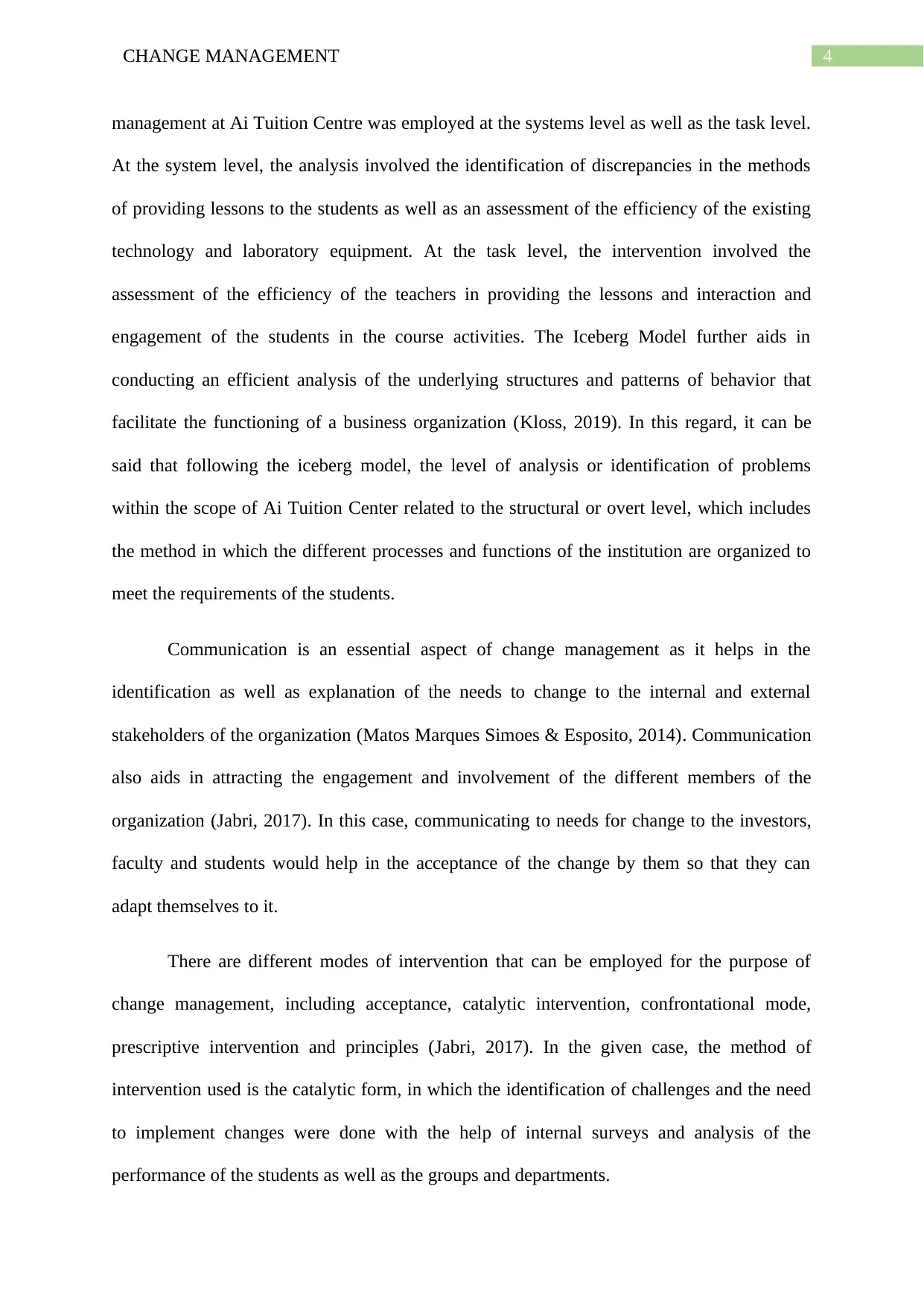
4CHANGE MANAGEMENT
management at Ai Tuition Centre was employed at the systems level as well as the task level.
At the system level, the analysis involved the identification of discrepancies in the methods
of providing lessons to the students as well as an assessment of the efficiency of the existing
technology and laboratory equipment. At the task level, the intervention involved the
assessment of the efficiency of the teachers in providing the lessons and interaction and
engagement of the students in the course activities. The Iceberg Model further aids in
conducting an efficient analysis of the underlying structures and patterns of behavior that
facilitate the functioning of a business organization (Kloss, 2019). In this regard, it can be
said that following the iceberg model, the level of analysis or identification of problems
within the scope of Ai Tuition Center related to the structural or overt level, which includes
the method in which the different processes and functions of the institution are organized to
meet the requirements of the students.
Communication is an essential aspect of change management as it helps in the
identification as well as explanation of the needs to change to the internal and external
stakeholders of the organization (Matos Marques Simoes & Esposito, 2014). Communication
also aids in attracting the engagement and involvement of the different members of the
organization (Jabri, 2017). In this case, communicating to needs for change to the investors,
faculty and students would help in the acceptance of the change by them so that they can
adapt themselves to it.
There are different modes of intervention that can be employed for the purpose of
change management, including acceptance, catalytic intervention, confrontational mode,
prescriptive intervention and principles (Jabri, 2017). In the given case, the method of
intervention used is the catalytic form, in which the identification of challenges and the need
to implement changes were done with the help of internal surveys and analysis of the
performance of the students as well as the groups and departments.
management at Ai Tuition Centre was employed at the systems level as well as the task level.
At the system level, the analysis involved the identification of discrepancies in the methods
of providing lessons to the students as well as an assessment of the efficiency of the existing
technology and laboratory equipment. At the task level, the intervention involved the
assessment of the efficiency of the teachers in providing the lessons and interaction and
engagement of the students in the course activities. The Iceberg Model further aids in
conducting an efficient analysis of the underlying structures and patterns of behavior that
facilitate the functioning of a business organization (Kloss, 2019). In this regard, it can be
said that following the iceberg model, the level of analysis or identification of problems
within the scope of Ai Tuition Center related to the structural or overt level, which includes
the method in which the different processes and functions of the institution are organized to
meet the requirements of the students.
Communication is an essential aspect of change management as it helps in the
identification as well as explanation of the needs to change to the internal and external
stakeholders of the organization (Matos Marques Simoes & Esposito, 2014). Communication
also aids in attracting the engagement and involvement of the different members of the
organization (Jabri, 2017). In this case, communicating to needs for change to the investors,
faculty and students would help in the acceptance of the change by them so that they can
adapt themselves to it.
There are different modes of intervention that can be employed for the purpose of
change management, including acceptance, catalytic intervention, confrontational mode,
prescriptive intervention and principles (Jabri, 2017). In the given case, the method of
intervention used is the catalytic form, in which the identification of challenges and the need
to implement changes were done with the help of internal surveys and analysis of the
performance of the students as well as the groups and departments.
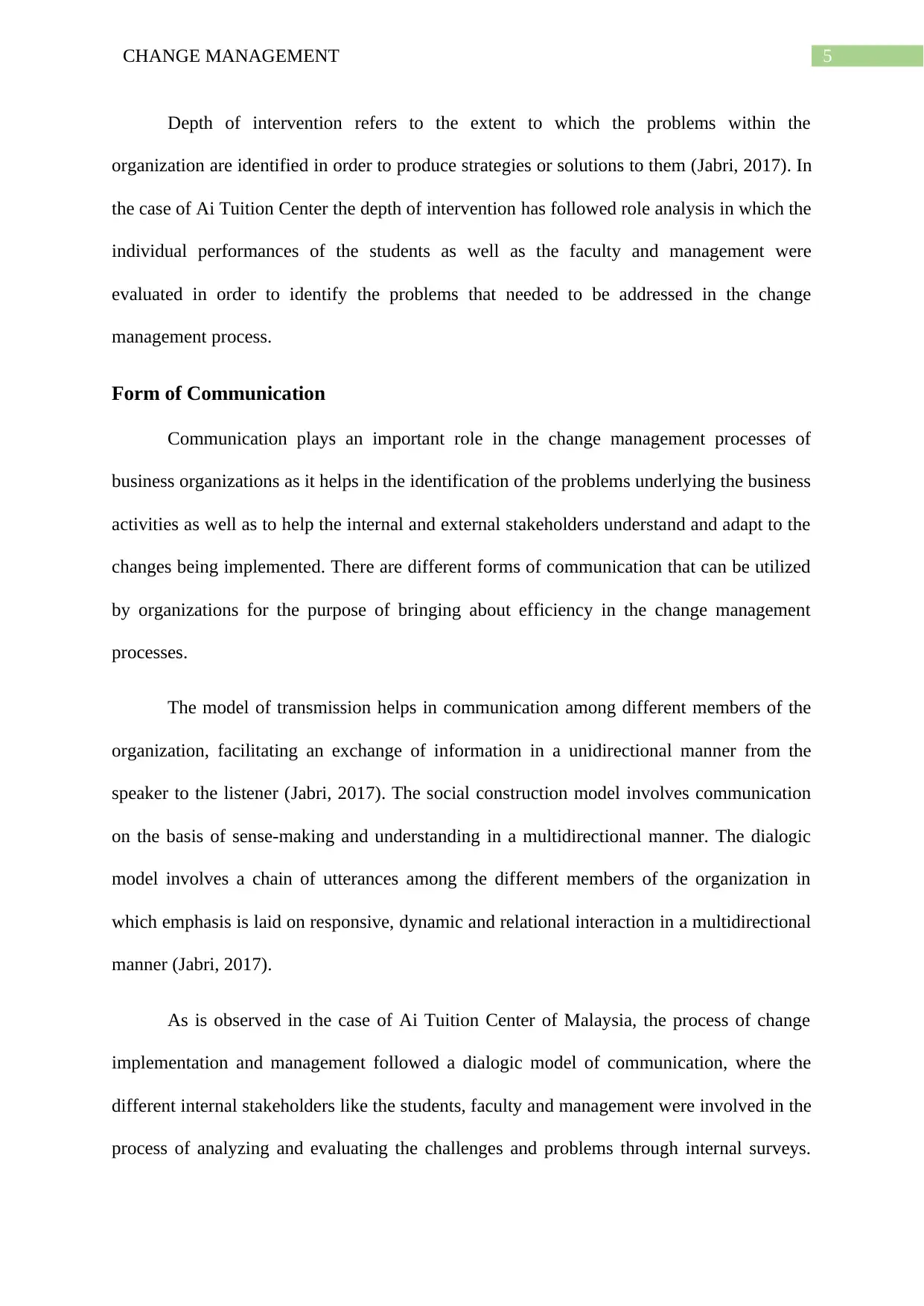
5CHANGE MANAGEMENT
Depth of intervention refers to the extent to which the problems within the
organization are identified in order to produce strategies or solutions to them (Jabri, 2017). In
the case of Ai Tuition Center the depth of intervention has followed role analysis in which the
individual performances of the students as well as the faculty and management were
evaluated in order to identify the problems that needed to be addressed in the change
management process.
Form of Communication
Communication plays an important role in the change management processes of
business organizations as it helps in the identification of the problems underlying the business
activities as well as to help the internal and external stakeholders understand and adapt to the
changes being implemented. There are different forms of communication that can be utilized
by organizations for the purpose of bringing about efficiency in the change management
processes.
The model of transmission helps in communication among different members of the
organization, facilitating an exchange of information in a unidirectional manner from the
speaker to the listener (Jabri, 2017). The social construction model involves communication
on the basis of sense-making and understanding in a multidirectional manner. The dialogic
model involves a chain of utterances among the different members of the organization in
which emphasis is laid on responsive, dynamic and relational interaction in a multidirectional
manner (Jabri, 2017).
As is observed in the case of Ai Tuition Center of Malaysia, the process of change
implementation and management followed a dialogic model of communication, where the
different internal stakeholders like the students, faculty and management were involved in the
process of analyzing and evaluating the challenges and problems through internal surveys.
Depth of intervention refers to the extent to which the problems within the
organization are identified in order to produce strategies or solutions to them (Jabri, 2017). In
the case of Ai Tuition Center the depth of intervention has followed role analysis in which the
individual performances of the students as well as the faculty and management were
evaluated in order to identify the problems that needed to be addressed in the change
management process.
Form of Communication
Communication plays an important role in the change management processes of
business organizations as it helps in the identification of the problems underlying the business
activities as well as to help the internal and external stakeholders understand and adapt to the
changes being implemented. There are different forms of communication that can be utilized
by organizations for the purpose of bringing about efficiency in the change management
processes.
The model of transmission helps in communication among different members of the
organization, facilitating an exchange of information in a unidirectional manner from the
speaker to the listener (Jabri, 2017). The social construction model involves communication
on the basis of sense-making and understanding in a multidirectional manner. The dialogic
model involves a chain of utterances among the different members of the organization in
which emphasis is laid on responsive, dynamic and relational interaction in a multidirectional
manner (Jabri, 2017).
As is observed in the case of Ai Tuition Center of Malaysia, the process of change
implementation and management followed a dialogic model of communication, where the
different internal stakeholders like the students, faculty and management were involved in the
process of analyzing and evaluating the challenges and problems through internal surveys.
⊘ This is a preview!⊘
Do you want full access?
Subscribe today to unlock all pages.

Trusted by 1+ million students worldwide
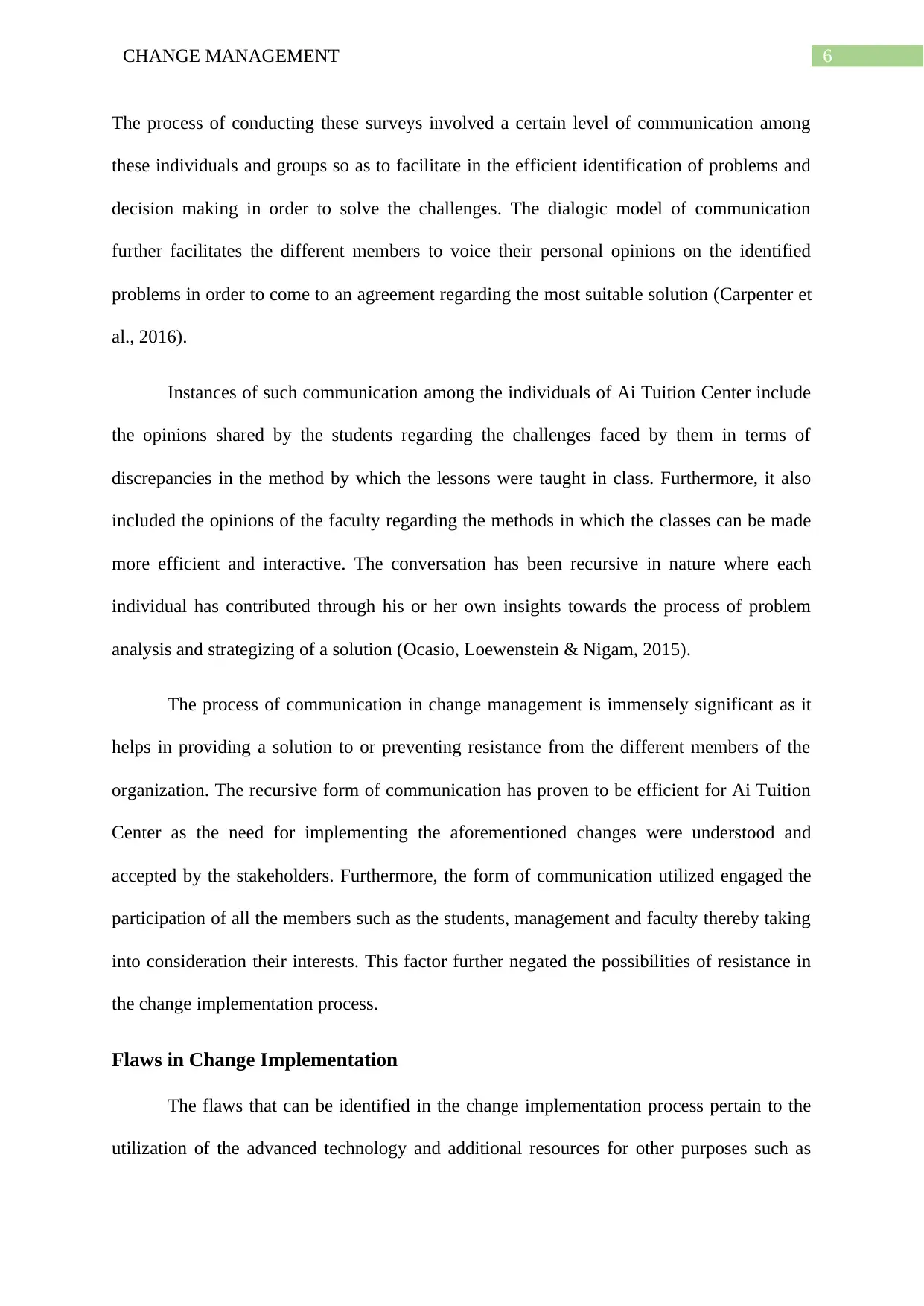
6CHANGE MANAGEMENT
The process of conducting these surveys involved a certain level of communication among
these individuals and groups so as to facilitate in the efficient identification of problems and
decision making in order to solve the challenges. The dialogic model of communication
further facilitates the different members to voice their personal opinions on the identified
problems in order to come to an agreement regarding the most suitable solution (Carpenter et
al., 2016).
Instances of such communication among the individuals of Ai Tuition Center include
the opinions shared by the students regarding the challenges faced by them in terms of
discrepancies in the method by which the lessons were taught in class. Furthermore, it also
included the opinions of the faculty regarding the methods in which the classes can be made
more efficient and interactive. The conversation has been recursive in nature where each
individual has contributed through his or her own insights towards the process of problem
analysis and strategizing of a solution (Ocasio, Loewenstein & Nigam, 2015).
The process of communication in change management is immensely significant as it
helps in providing a solution to or preventing resistance from the different members of the
organization. The recursive form of communication has proven to be efficient for Ai Tuition
Center as the need for implementing the aforementioned changes were understood and
accepted by the stakeholders. Furthermore, the form of communication utilized engaged the
participation of all the members such as the students, management and faculty thereby taking
into consideration their interests. This factor further negated the possibilities of resistance in
the change implementation process.
Flaws in Change Implementation
The flaws that can be identified in the change implementation process pertain to the
utilization of the advanced technology and additional resources for other purposes such as
The process of conducting these surveys involved a certain level of communication among
these individuals and groups so as to facilitate in the efficient identification of problems and
decision making in order to solve the challenges. The dialogic model of communication
further facilitates the different members to voice their personal opinions on the identified
problems in order to come to an agreement regarding the most suitable solution (Carpenter et
al., 2016).
Instances of such communication among the individuals of Ai Tuition Center include
the opinions shared by the students regarding the challenges faced by them in terms of
discrepancies in the method by which the lessons were taught in class. Furthermore, it also
included the opinions of the faculty regarding the methods in which the classes can be made
more efficient and interactive. The conversation has been recursive in nature where each
individual has contributed through his or her own insights towards the process of problem
analysis and strategizing of a solution (Ocasio, Loewenstein & Nigam, 2015).
The process of communication in change management is immensely significant as it
helps in providing a solution to or preventing resistance from the different members of the
organization. The recursive form of communication has proven to be efficient for Ai Tuition
Center as the need for implementing the aforementioned changes were understood and
accepted by the stakeholders. Furthermore, the form of communication utilized engaged the
participation of all the members such as the students, management and faculty thereby taking
into consideration their interests. This factor further negated the possibilities of resistance in
the change implementation process.
Flaws in Change Implementation
The flaws that can be identified in the change implementation process pertain to the
utilization of the advanced technology and additional resources for other purposes such as
Paraphrase This Document
Need a fresh take? Get an instant paraphrase of this document with our AI Paraphraser
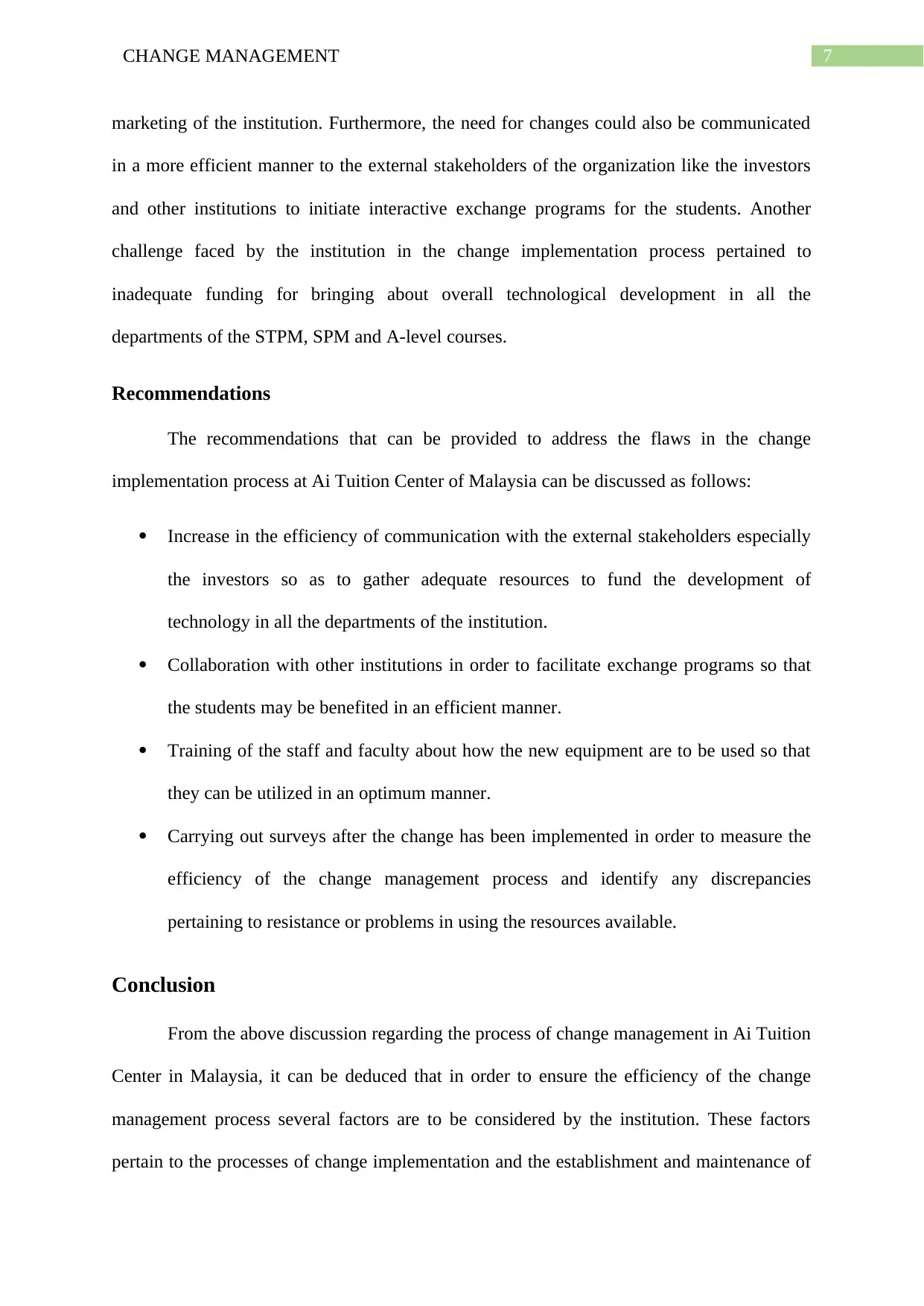
7CHANGE MANAGEMENT
marketing of the institution. Furthermore, the need for changes could also be communicated
in a more efficient manner to the external stakeholders of the organization like the investors
and other institutions to initiate interactive exchange programs for the students. Another
challenge faced by the institution in the change implementation process pertained to
inadequate funding for bringing about overall technological development in all the
departments of the STPM, SPM and A-level courses.
Recommendations
The recommendations that can be provided to address the flaws in the change
implementation process at Ai Tuition Center of Malaysia can be discussed as follows:
Increase in the efficiency of communication with the external stakeholders especially
the investors so as to gather adequate resources to fund the development of
technology in all the departments of the institution.
Collaboration with other institutions in order to facilitate exchange programs so that
the students may be benefited in an efficient manner.
Training of the staff and faculty about how the new equipment are to be used so that
they can be utilized in an optimum manner.
Carrying out surveys after the change has been implemented in order to measure the
efficiency of the change management process and identify any discrepancies
pertaining to resistance or problems in using the resources available.
Conclusion
From the above discussion regarding the process of change management in Ai Tuition
Center in Malaysia, it can be deduced that in order to ensure the efficiency of the change
management process several factors are to be considered by the institution. These factors
pertain to the processes of change implementation and the establishment and maintenance of
marketing of the institution. Furthermore, the need for changes could also be communicated
in a more efficient manner to the external stakeholders of the organization like the investors
and other institutions to initiate interactive exchange programs for the students. Another
challenge faced by the institution in the change implementation process pertained to
inadequate funding for bringing about overall technological development in all the
departments of the STPM, SPM and A-level courses.
Recommendations
The recommendations that can be provided to address the flaws in the change
implementation process at Ai Tuition Center of Malaysia can be discussed as follows:
Increase in the efficiency of communication with the external stakeholders especially
the investors so as to gather adequate resources to fund the development of
technology in all the departments of the institution.
Collaboration with other institutions in order to facilitate exchange programs so that
the students may be benefited in an efficient manner.
Training of the staff and faculty about how the new equipment are to be used so that
they can be utilized in an optimum manner.
Carrying out surveys after the change has been implemented in order to measure the
efficiency of the change management process and identify any discrepancies
pertaining to resistance or problems in using the resources available.
Conclusion
From the above discussion regarding the process of change management in Ai Tuition
Center in Malaysia, it can be deduced that in order to ensure the efficiency of the change
management process several factors are to be considered by the institution. These factors
pertain to the processes of change implementation and the establishment and maintenance of
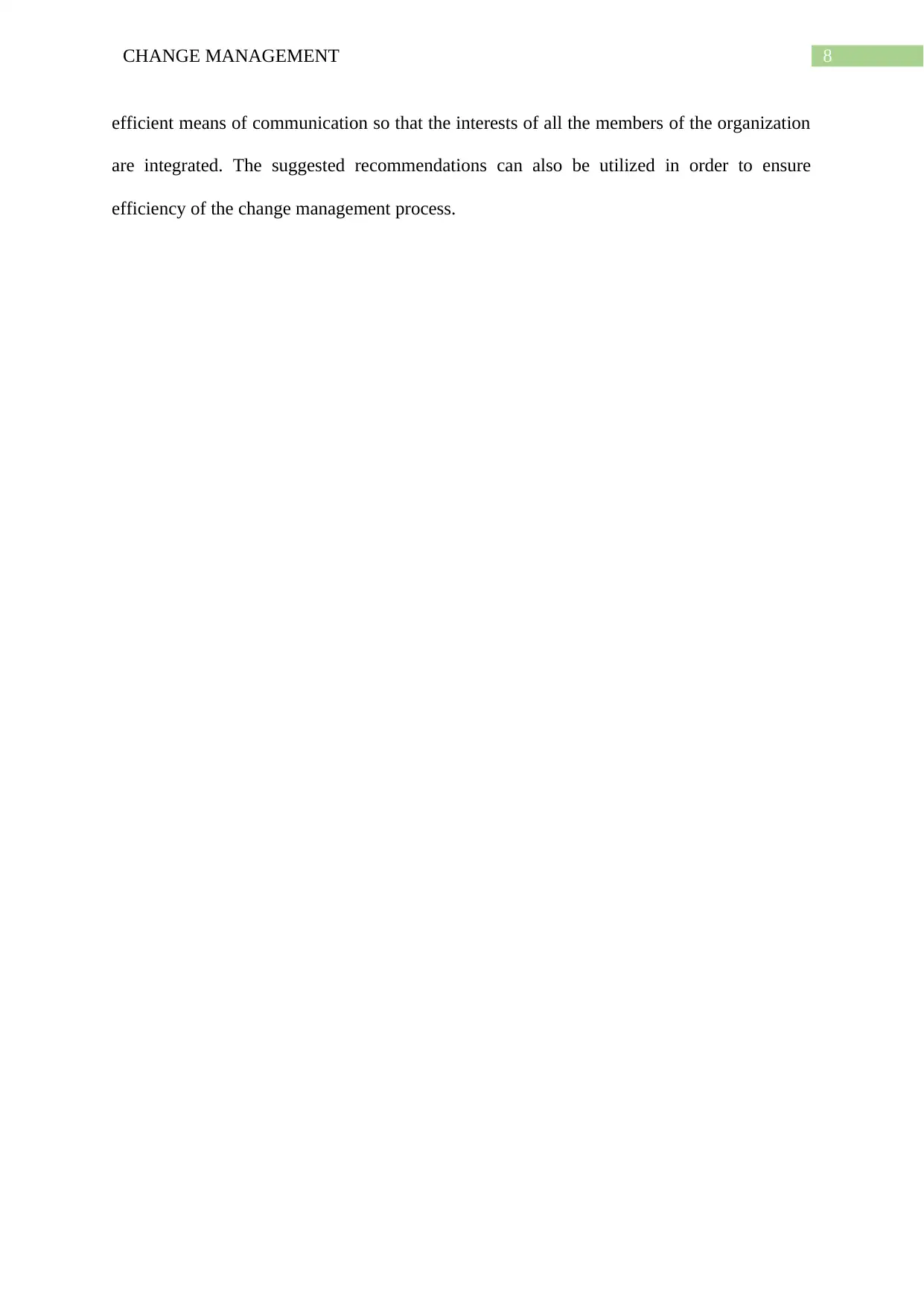
8CHANGE MANAGEMENT
efficient means of communication so that the interests of all the members of the organization
are integrated. The suggested recommendations can also be utilized in order to ensure
efficiency of the change management process.
efficient means of communication so that the interests of all the members of the organization
are integrated. The suggested recommendations can also be utilized in order to ensure
efficiency of the change management process.
⊘ This is a preview!⊘
Do you want full access?
Subscribe today to unlock all pages.

Trusted by 1+ million students worldwide
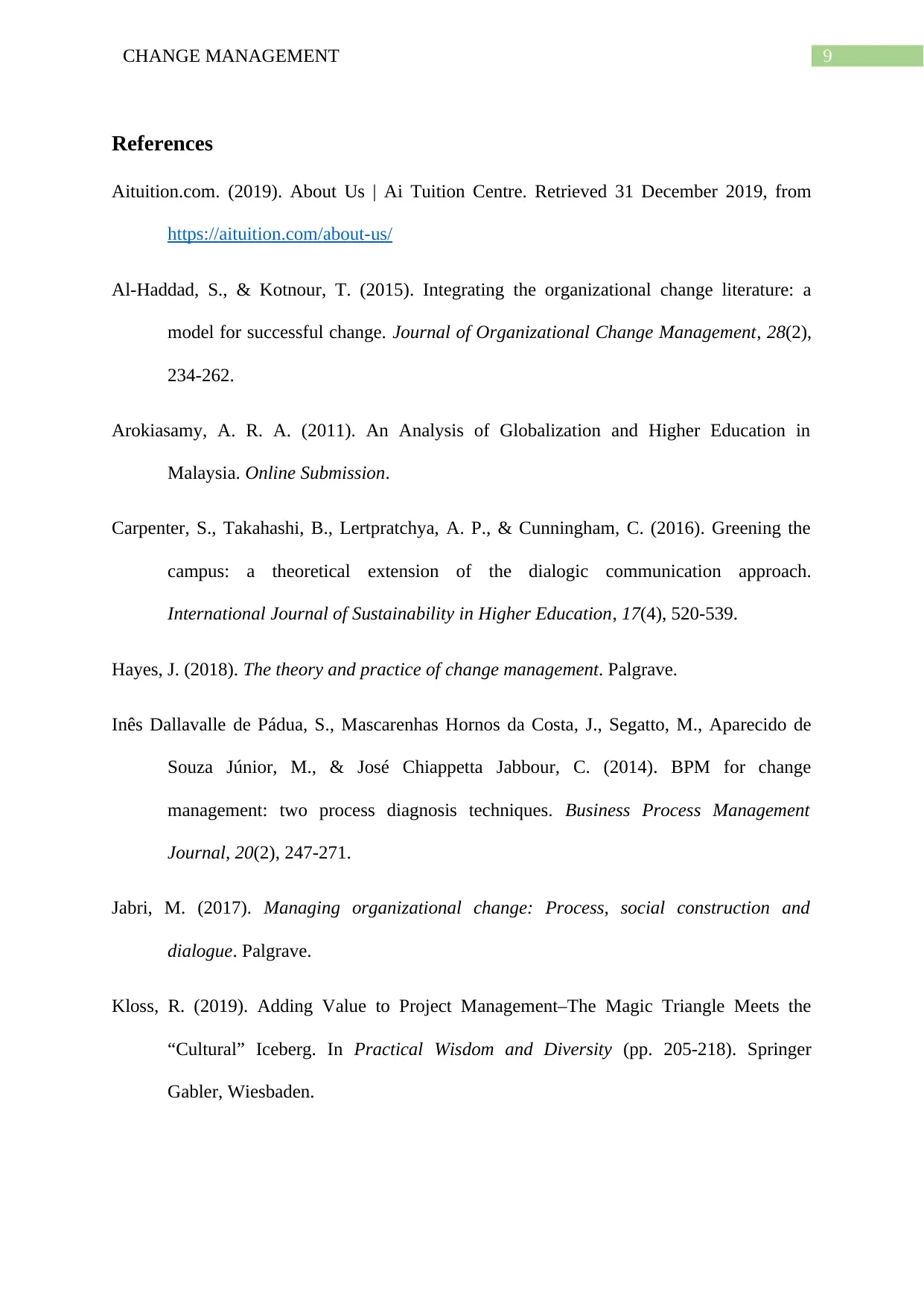
9CHANGE MANAGEMENT
References
Aituition.com. (2019). About Us | Ai Tuition Centre. Retrieved 31 December 2019, from
https://aituition.com/about-us/
Al-Haddad, S., & Kotnour, T. (2015). Integrating the organizational change literature: a
model for successful change. Journal of Organizational Change Management, 28(2),
234-262.
Arokiasamy, A. R. A. (2011). An Analysis of Globalization and Higher Education in
Malaysia. Online Submission.
Carpenter, S., Takahashi, B., Lertpratchya, A. P., & Cunningham, C. (2016). Greening the
campus: a theoretical extension of the dialogic communication approach.
International Journal of Sustainability in Higher Education, 17(4), 520-539.
Hayes, J. (2018). The theory and practice of change management. Palgrave.
Inês Dallavalle de Pádua, S., Mascarenhas Hornos da Costa, J., Segatto, M., Aparecido de
Souza Júnior, M., & José Chiappetta Jabbour, C. (2014). BPM for change
management: two process diagnosis techniques. Business Process Management
Journal, 20(2), 247-271.
Jabri, M. (2017). Managing organizational change: Process, social construction and
dialogue. Palgrave.
Kloss, R. (2019). Adding Value to Project Management–The Magic Triangle Meets the
“Cultural” Iceberg. In Practical Wisdom and Diversity (pp. 205-218). Springer
Gabler, Wiesbaden.
References
Aituition.com. (2019). About Us | Ai Tuition Centre. Retrieved 31 December 2019, from
https://aituition.com/about-us/
Al-Haddad, S., & Kotnour, T. (2015). Integrating the organizational change literature: a
model for successful change. Journal of Organizational Change Management, 28(2),
234-262.
Arokiasamy, A. R. A. (2011). An Analysis of Globalization and Higher Education in
Malaysia. Online Submission.
Carpenter, S., Takahashi, B., Lertpratchya, A. P., & Cunningham, C. (2016). Greening the
campus: a theoretical extension of the dialogic communication approach.
International Journal of Sustainability in Higher Education, 17(4), 520-539.
Hayes, J. (2018). The theory and practice of change management. Palgrave.
Inês Dallavalle de Pádua, S., Mascarenhas Hornos da Costa, J., Segatto, M., Aparecido de
Souza Júnior, M., & José Chiappetta Jabbour, C. (2014). BPM for change
management: two process diagnosis techniques. Business Process Management
Journal, 20(2), 247-271.
Jabri, M. (2017). Managing organizational change: Process, social construction and
dialogue. Palgrave.
Kloss, R. (2019). Adding Value to Project Management–The Magic Triangle Meets the
“Cultural” Iceberg. In Practical Wisdom and Diversity (pp. 205-218). Springer
Gabler, Wiesbaden.
Paraphrase This Document
Need a fresh take? Get an instant paraphrase of this document with our AI Paraphraser
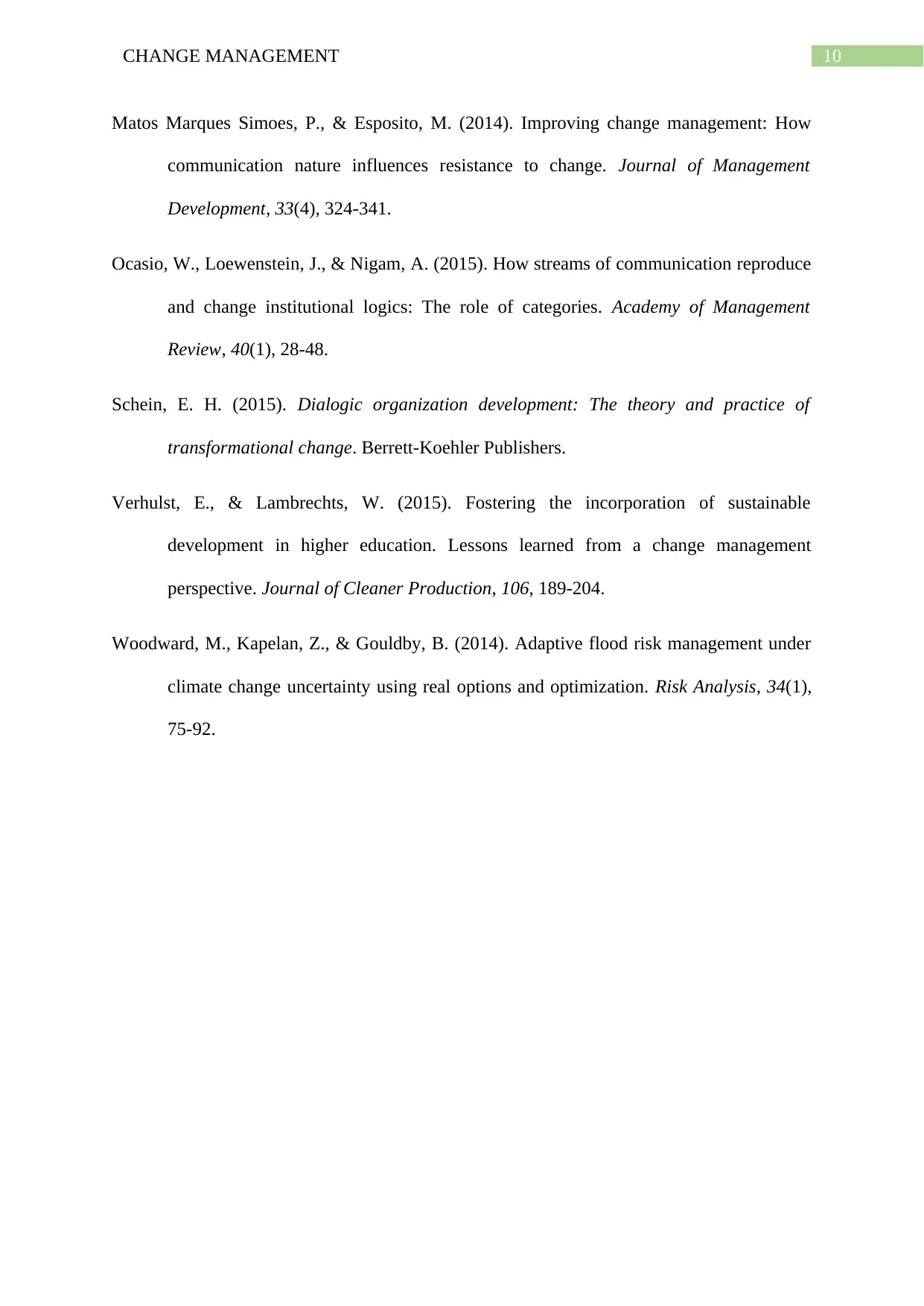
10CHANGE MANAGEMENT
Matos Marques Simoes, P., & Esposito, M. (2014). Improving change management: How
communication nature influences resistance to change. Journal of Management
Development, 33(4), 324-341.
Ocasio, W., Loewenstein, J., & Nigam, A. (2015). How streams of communication reproduce
and change institutional logics: The role of categories. Academy of Management
Review, 40(1), 28-48.
Schein, E. H. (2015). Dialogic organization development: The theory and practice of
transformational change. Berrett-Koehler Publishers.
Verhulst, E., & Lambrechts, W. (2015). Fostering the incorporation of sustainable
development in higher education. Lessons learned from a change management
perspective. Journal of Cleaner Production, 106, 189-204.
Woodward, M., Kapelan, Z., & Gouldby, B. (2014). Adaptive flood risk management under
climate change uncertainty using real options and optimization. Risk Analysis, 34(1),
75-92.
Matos Marques Simoes, P., & Esposito, M. (2014). Improving change management: How
communication nature influences resistance to change. Journal of Management
Development, 33(4), 324-341.
Ocasio, W., Loewenstein, J., & Nigam, A. (2015). How streams of communication reproduce
and change institutional logics: The role of categories. Academy of Management
Review, 40(1), 28-48.
Schein, E. H. (2015). Dialogic organization development: The theory and practice of
transformational change. Berrett-Koehler Publishers.
Verhulst, E., & Lambrechts, W. (2015). Fostering the incorporation of sustainable
development in higher education. Lessons learned from a change management
perspective. Journal of Cleaner Production, 106, 189-204.
Woodward, M., Kapelan, Z., & Gouldby, B. (2014). Adaptive flood risk management under
climate change uncertainty using real options and optimization. Risk Analysis, 34(1),
75-92.
1 out of 11
Related Documents
Your All-in-One AI-Powered Toolkit for Academic Success.
+13062052269
info@desklib.com
Available 24*7 on WhatsApp / Email
![[object Object]](/_next/static/media/star-bottom.7253800d.svg)
Unlock your academic potential
Copyright © 2020–2025 A2Z Services. All Rights Reserved. Developed and managed by ZUCOL.





